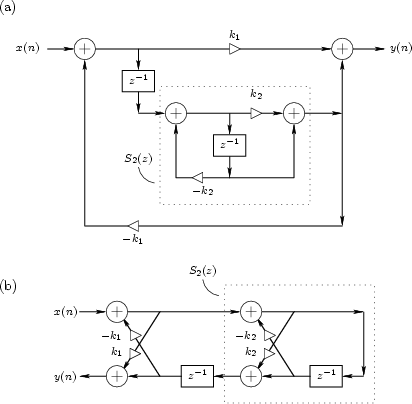An interesting property of allpass filters is that they can be
nested [144,145]. That is, if ![]() and
and
![]() denote unity-gain allpass transfer functions, then both
denote unity-gain allpass transfer functions, then both
![]() and
and
![]() are allpass filters. A proof can be
based on the observation that, since
are allpass filters. A proof can be
based on the observation that, since
![]() ,
, ![]() can
be viewed as a conformal map
[304] which maps the unit circle in the
can
be viewed as a conformal map
[304] which maps the unit circle in the ![]() plane to itself;
therefore, the set of all such maps is closed under functional
composition.
plane to itself;
therefore, the set of all such maps is closed under functional
composition.
An important class of nested allpass filters is obtained by nesting first-order allpass filters of the form
The equivalence of nested allpass filters to lattice filters has computational significance since it is well known that the two-multiply lattice sections can be replaced by one-multiply lattice sections [275,294].
 |
 |
In summary, nested first-order allpass filters are equivalent to lattice filters made of two-multiply lattice sections. In §G.8.1, a one-multiply section is derived which is not only less expensive to implement in hardware, but it additionally has a direct interpretation as a physical model.